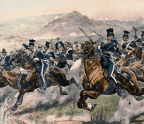SHIP OF GHOSTS

On March 15, 1943, the Japanese destroyer Akikaze anchored at Kairiru Island, just off the northeast coast of New Guinea. A landing party went ashore and soon returned with a German Catholic bishop, a few dozen priests and nuns, a female servant and two orphans. Akikaze then sailed northeast to Manus Island, where two days later it picked up a score of German Protestant missionaries and civilians. While the Japanese sailors were standoffish with their reluctant passengers, they did not mistreat anyone. Within hours, however, all of the civilians—men, women and children alike—would be killed, their bodies thrown overboard.
During World War II Japanese troops commanded the grudging respect of Allied forces as fighting men but were widely condemned for their barbaric treatment of civilians and prisoners of war. The citizens of neutral nations, and even some of those in league with Japan, suffered badly at the hands of imperial authorities, who responded to any perceived threat with extreme violence. The well-recorded atrocities stemmed from Tokyo’s harsh treatment of its own troops, which shaped their training and mind-set even before the outbreak of war.
In 1931, under the administration of Prime Minister Inukai Tsuyoshi, Lt. Gen. Sadao Araki was appointed minister of war, a cabinet position that gave him widespread influence and enabled him to spread his own brand of radicalism within the military establishment. Araki was the author of (the “Imperial Way”), a political philosophy that promoted totalitarian rule, militarism and expansion. He also strongly advocated the—spiritual training of Japanese troops based loosely on the centuries-old samurai warrior code. Araki was forced to retire in the wake of a failed coup in 1936, but two years later he was appointed education minister, a position affording him access through the national education system to infuse his beliefs into schools.
You’re reading a preview, subscribe to read more.
Start your free 30 days



